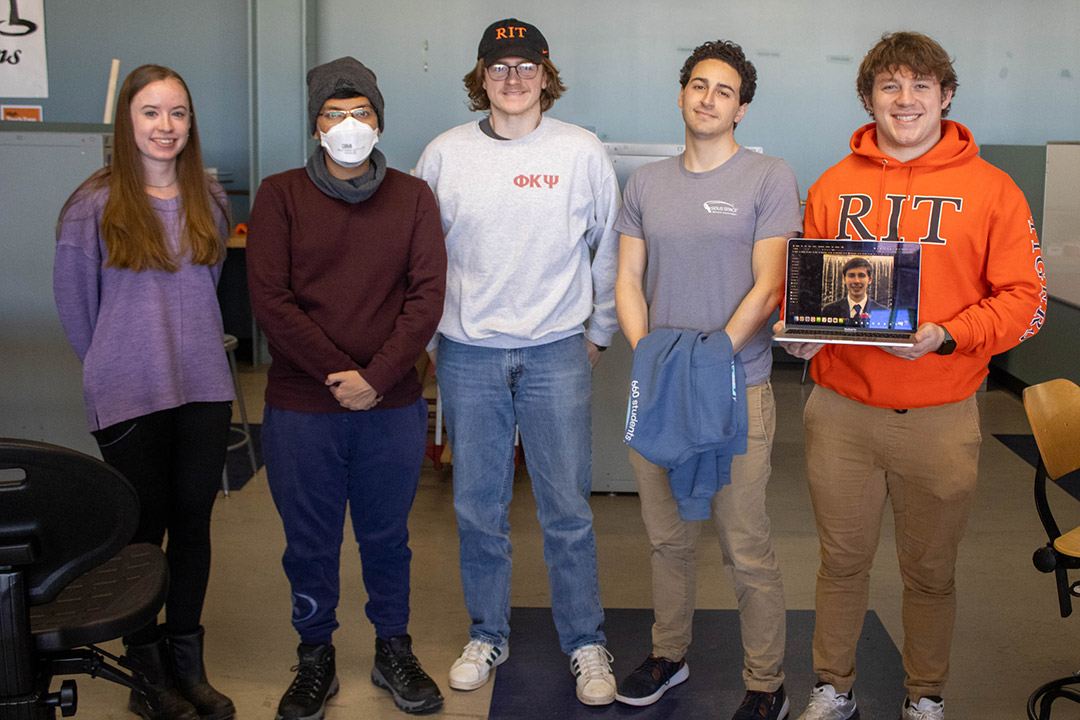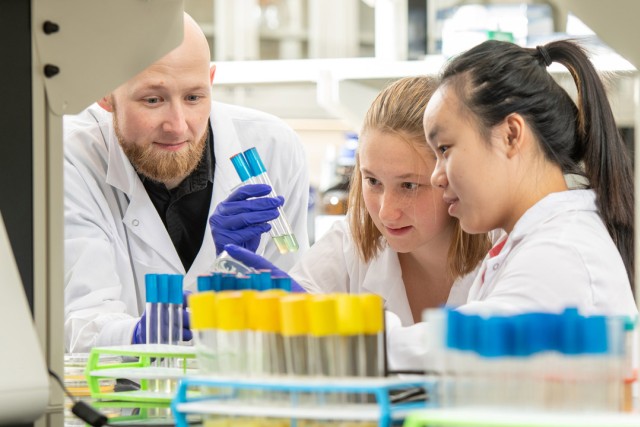RIT students create innovative prototype for blood pressure cuffs
The students are working to provide doctors with more accurate equipment to measure blood pressure
supplied photo
Aidan Hughes, left, and Barak Binyamin configure the prototype of the automatic blood pressure cuff in the Multidisciplinary Senior Design projects lab.
According to the Huberman Lab health and science podcast, many doctors question the accuracy of automatic blood pressure cuffs. That news surprised fifth-year biomedical engineering student Aidan Hughes and led him to pitch his idea to make a more accurate automatic blood pressure cuff.
Auscultation, which is the process doctors use to listen to someone’s heart and lungs through a stethoscope, is currently the most accurate way to measure someone’s blood pressure. However, the automatic blood pressure cuffs that are in use today are unable to listen to someone’s heart to accurately make these measurements.
Hughes’s pitch, which was submitted this past summer to Associate Professor Elizabeth DeBartolo, head of the Multidisciplinary Senior Design program, was approved and the project was funded, giving him and the other students working on the project the materials they needed to begin work on the yearlong endeavor as part of the course in the Kate Gleason College of Engineering.
supplied image
The auscultation-based blood pressure cuff team. Pictured, from left to right, are Amelia Gilbert, Ayush Jha, Brandon Watkins, Barak Binyamin, and Aidan Hughes. Logan Clasby is pictured on the laptop.
“Current automatic blood pressure cuffs that are in use sense vibrations in your blood vessels and, by using math, can figure out what your blood pressure is. This is an OK method, and it gets you close, but there is a lot of variability to it because the vibrations are not the same from person to person,” said Hughes.
According to Hughes, doctors use Korotkoff sounds to calculate one’s blood pressure. The team’s new-and-improved automatic blood pressure cuff uses a few different systems to essentially “listen” for these sounds to give more accurate readings.
At least twice a week, Hughes and group members Amelia Gilbert, a fifth-year biomedical engineering student; Barak Binyamin, a fifth-year computer engineering student; Logan Clasby, a fifth-year electrical engineering student; Ayush Jha, a fifth-year mechanical engineering student; and Brandon Watkins, a fifth-year mechanical engineering student, venture to the engineering lab and spend hours designing, troubleshooting, and innovating their prototype to further refine their work.
Each member brings their own skill set to the table to collaborate on the multidisciplinary project. They also seek support from faculty and staff within the College of Engineering and discuss the project with their peers. Hughes hopes that the prototype can pave the way for further development and become commercially viable in the medical industry.
The students work closely with their adviser, Carlos Barrios, an electrical engineering lecturer who guides them through the process and acts as a resource if they need extra support. Barrios enjoys working with the students and is delighted that a student-pitched proposal has seen so much success, especially due to the challenges that can come with a multidisciplinary project.
“I see the hard work that the students put into this project, and it makes it even better to see them succeed and have these breakthroughs after they’ve been scratching their heads for a while,” Barrios said.
Other projects within the multidisciplinary senior design class have been pitched to RIT students from various companies seeking help for alternative solutions and creating innovative designs in industries ranging from defense to healthcare to many other forms of engineering.
The auscultation-based automatic blood pressure cuff team plans to present their finished prototype at Imagine RIT: Creativity and Innovation Festival on April 27.




